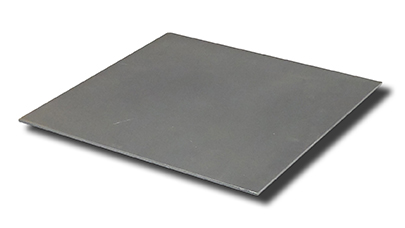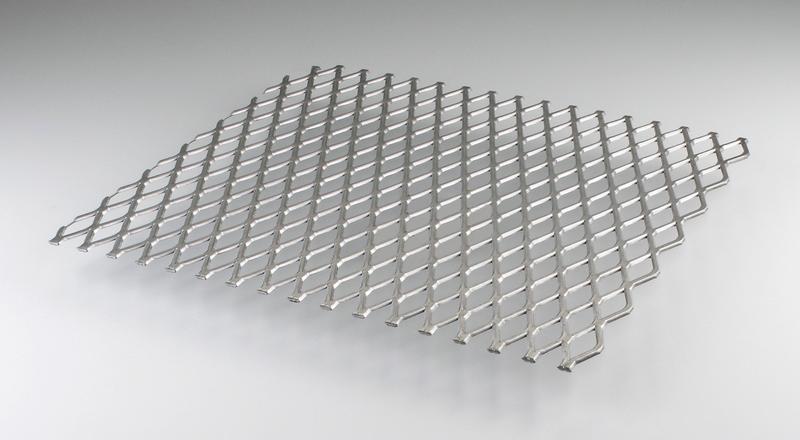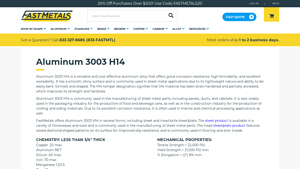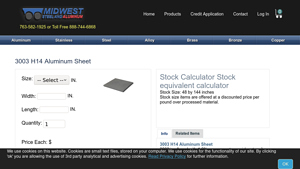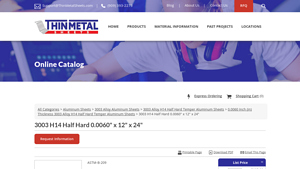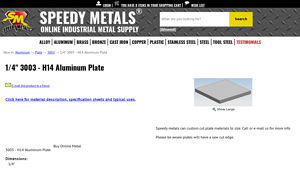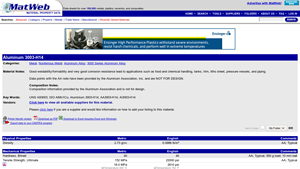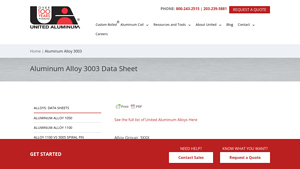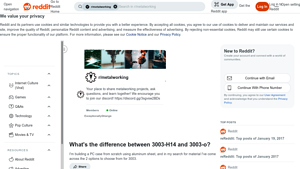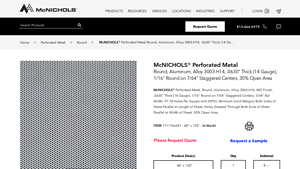3003 H14 Aluminum Guide: Type, Cost, Top List…
Introduction: Navigating the Global Market for 3003 h14 aluminum
In today’s dynamic global market, sourcing high-quality 3003 H14 aluminum presents a unique set of challenges for international B2B buyers. With its exceptional corrosion resistance, lightweight nature, and excellent formability, 3003 H14 aluminum is a preferred choice across diverse industries, including construction, packaging, and marine applications. However, navigating the complexities of sourcing this versatile alloy—especially for buyers in regions like Africa, South America, the Middle East, and Europe—can be daunting. This guide aims to equip you with the knowledge and tools needed to make informed purchasing decisions, covering essential aspects such as product specifications, common applications, supplier vetting processes, and cost considerations.
Understanding the nuances of 3003 H14 aluminum is crucial for optimizing your procurement strategy. This comprehensive resource will delve into the various forms and thicknesses available, ensuring you can select the right product for your specific needs. Additionally, we will discuss the importance of reliable suppliers and the factors that influence pricing, helping you identify opportunities for cost savings without compromising on quality. By the end of this guide, you will be empowered to confidently navigate the global market for 3003 H14 aluminum, ensuring your business remains competitive and well-equipped to meet its operational demands.
Understanding 3003 h14 aluminum Types and Variations
| Type Name | Key Distinguishing Features | Primary B2B Applications | Brief Pros & Cons for Buyers |
|---|---|---|---|
| 3003 H14 Aluminum Sheet | Good formability, corrosion resistance, smooth finish | Sheet metal parts, packaging, construction | Pros: Lightweight, easy to work with. Cons: Limited strength compared to other alloys. |
| 3003 H14 Tread Plate | Raised diamond pattern for slip resistance | Flooring, stair treads, industrial applications | Pros: Enhanced safety, durable. Cons: Slightly heavier than standard sheets. |
| 3003 H14 Aluminum Plate | Thicker gauge, high strength and durability | Structural components, marine applications | Pros: Excellent strength, good weldability. Cons: Higher cost than thinner sheets. |
| 3003 H14 Aluminum Coil | Rolled form, flexible thickness options | HVAC ducts, automotive parts | Pros: Versatile, customizable sizes. Cons: Requires careful handling to avoid damage. |
| 3003 H14 Half Hard Sheet | Intermediate strength, good formability | Automotive panels, decorative applications | Pros: Balance of strength and workability. Cons: Limited elongation compared to softer variants. |
What are the Characteristics of 3003 H14 Aluminum Sheets?
3003 H14 aluminum sheets are characterized by their excellent formability and corrosion resistance, making them ideal for a variety of applications such as sheet metal parts and food packaging. Their smooth surface finish allows for easy cleaning and aesthetic appeal, which is particularly valuable in industries like food service and construction. When purchasing, buyers should consider thickness options and the specific requirements of their applications, as these factors can significantly influence performance and cost.
Why Choose 3003 H14 Tread Plates for Safety Applications?
3003 H14 tread plates feature a raised diamond pattern that provides enhanced slip resistance, making them suitable for flooring and stair treads in industrial settings. This type of aluminum is durable and resistant to corrosion, which is crucial for outdoor applications. B2B buyers should weigh the benefits of increased safety against the slightly higher weight and cost compared to standard sheets, particularly in projects where weight is a critical factor.
How Do 3003 H14 Aluminum Plates Stand Out?
3003 H14 aluminum plates are thicker and provide greater strength and durability compared to their sheet counterparts. This makes them suitable for structural components and marine applications where strength is paramount. Buyers must consider the cost implications of using thicker materials, as well as the required machining capabilities for their specific applications, to ensure that they are making a cost-effective choice without compromising on quality.
What Are the Benefits of 3003 H14 Aluminum Coils?
3003 H14 aluminum coils are rolled forms that offer flexibility in thickness and dimensions, catering to various applications such as HVAC ducts and automotive parts. Their versatility allows for customization based on specific project needs. Buyers should be mindful of handling requirements, as coils can be prone to damage if not properly managed during transportation and installation.
What is the Advantage of 3003 H14 Half Hard Sheets?
3003 H14 half hard sheets provide a balance of strength and workability, making them suitable for automotive panels and decorative elements. This type of aluminum allows for moderate forming and bending while maintaining sufficient strength for practical applications. When considering these sheets, buyers should evaluate their specific needs for strength versus formability to ensure they select the right material for their projects.
Key Industrial Applications of 3003 h14 aluminum
| Industry/Sector | Specific Application of 3003 h14 aluminum | Value/Benefit for the Business | Key Sourcing Considerations for this Application |
|---|---|---|---|
| Food and Beverage | Manufacturing of beverage cans and food packaging | Lightweight, corrosion-resistant, and recyclable material | Ensure compliance with food safety regulations and quality standards. |
| Construction | Roofing and siding materials | Durable, weather-resistant, and aesthetically pleasing | Assess local climate conditions to select appropriate thickness and finish. |
| Automotive | Fuel tanks and body panels | Enhanced strength-to-weight ratio, improving fuel efficiency | Verify compatibility with welding and forming processes. |
| HVAC and Ductwork | Ducts and ventilation systems | Excellent formability and corrosion resistance | Consider custom sizes and thicknesses to meet specific project needs. |
| Marine and Chemical | Components for marine applications and chemical processing | High corrosion resistance suitable for harsh environments | Evaluate specific marine or chemical exposure conditions for material selection. |
How is 3003 H14 Aluminum Used in Food and Beverage Applications?
In the food and beverage industry, 3003 H14 aluminum is primarily used in the manufacturing of beverage cans and food packaging materials. Its lightweight nature and excellent corrosion resistance make it ideal for preserving product integrity while minimizing transportation costs. Buyers in this sector must ensure that the aluminum complies with stringent food safety regulations, including FDA standards, to guarantee that the packaging is safe for consumer use.
What Role Does 3003 H14 Aluminum Play in Construction?
Construction applications leverage 3003 H14 aluminum for roofing and siding materials. Its durability and aesthetic appeal make it a popular choice among builders. The alloy’s lightweight characteristic facilitates easier handling and installation, contributing to reduced labor costs. International buyers should consider local climate conditions, as this may influence the selection of thickness and surface finish to ensure longevity and performance.
How is 3003 H14 Aluminum Applied in the Automotive Industry?
In the automotive sector, 3003 H14 aluminum is utilized for fuel tanks and body panels. The alloy’s enhanced strength-to-weight ratio not only supports vehicle performance but also improves fuel efficiency. B2B buyers should verify that the aluminum is compatible with various welding and forming processes, as this ensures seamless integration into production lines and compliance with industry standards.
Why is 3003 H14 Aluminum Important for HVAC and Ductwork?
In HVAC applications, 3003 H14 aluminum is favored for ductwork and ventilation systems due to its excellent formability and corrosion resistance. This alloy allows manufacturers to create custom shapes and sizes that fit specific installation requirements. Buyers should consider sourcing options that offer flexibility in dimensions and thicknesses to match the unique specifications of their projects.
What Makes 3003 H14 Aluminum Suitable for Marine and Chemical Applications?
3003 H14 aluminum is highly regarded in marine and chemical processing industries for its superior corrosion resistance, making it ideal for components exposed to harsh environments. This property ensures longevity and reduces maintenance costs. When sourcing this material, buyers should evaluate the specific environmental conditions, such as salinity and chemical exposure, to determine the most suitable grade and treatment for their needs.
3 Common User Pain Points for ‘3003 h14 aluminum’ & Their Solutions
Scenario 1: Ensuring Consistent Quality in Sheet Metal Fabrication
The Problem: B2B buyers often face challenges with the consistency of 3003 H14 aluminum sheets during the fabrication process. Variations in thickness, alloy composition, and surface quality can lead to significant manufacturing defects, impacting product performance and increasing costs. For instance, if a buyer orders a specific thickness for a project but receives sheets that are either thinner or thicker, it can disrupt production schedules and result in wasted materials.
The Solution: To mitigate these issues, buyers should establish a clear set of specifications with their suppliers before placing orders. This includes precise thickness tolerances and alloy composition limits. Additionally, it’s beneficial to request certification documents that confirm compliance with ASTM standards such as ASTM B209. Regular communication with suppliers and conducting quality checks upon delivery can also help ensure that the materials meet the required specifications. Implementing a quality assurance protocol, including random sampling and testing of materials, can help catch discrepancies early in the production cycle, thereby reducing the risk of defects and costly reworks.
Scenario 2: Navigating Supply Chain Disruptions for Timely Deliveries
The Problem: Global supply chain disruptions can severely impact the availability of 3003 H14 aluminum, causing delays in production and affecting delivery timelines. Buyers in regions like Africa and South America may find it particularly challenging to source this material due to logistical issues and fluctuating market conditions. Delays can lead to missed deadlines for projects, resulting in financial penalties and damage to client relationships.
The Solution: To address supply chain challenges, buyers should diversify their supplier base. Establishing relationships with multiple suppliers across different regions can provide alternative sourcing options during disruptions. Additionally, implementing an inventory management system that tracks lead times and reorder points can help maintain a buffer stock of 3003 H14 aluminum. This proactive approach allows businesses to respond quickly to fluctuations in supply and ensures that production schedules remain on track. Leveraging technology such as supply chain management software can also enhance visibility into supplier performance and inventory levels.
Scenario 3: Maximizing the Value of 3003 H14 Aluminum in Diverse Applications
The Problem: Buyers may struggle to understand the full range of applications for 3003 H14 aluminum, which can limit its utilization and lead to suboptimal purchasing decisions. For example, while some buyers may primarily see it as suitable for sheet metal work, they might overlook its advantages in sectors like packaging, construction, or marine applications. This narrow perspective can lead to missed opportunities for cost savings and improved product performance.
The Solution: To maximize the value derived from 3003 H14 aluminum, buyers should invest in educational resources that detail the alloy’s properties and applications. Engaging with industry experts or attending webinars can provide insights into how 3003 H14 aluminum can be effectively used in various projects. Additionally, buyers should collaborate closely with design and engineering teams to explore innovative applications of the alloy that align with their business objectives. Creating a centralized repository of information on the different uses and benefits of 3003 H14 aluminum can also serve as a valuable resource for decision-making, enabling buyers to make informed purchases that enhance their product offerings and competitive edge.
Strategic Material Selection Guide for 3003 h14 aluminum
What Are the Key Properties of 3003 H14 Aluminum for B2B Applications?
Aluminum 3003 H14 is a widely utilized alloy known for its excellent corrosion resistance, high formability, and good weldability. It is primarily alloyed with manganese, which enhances its strength and makes it suitable for various applications. The H14 temper indicates that the material has been strain-hardened and partially annealed, resulting in improved mechanical properties. With a tensile strength ranging from 17,000 to 30,000 psi, it is ideal for applications requiring moderate strength and excellent workability.
What Are the Advantages and Disadvantages of Using 3003 H14 Aluminum?
Advantages:
1. Corrosion Resistance: The alloy exhibits strong resistance to corrosion, making it suitable for marine and chemical processing applications.
2. Formability: Its excellent formability allows for easy bending, shaping, and fabrication, which is crucial for manufacturers looking to create complex designs.
3. Cost-Effectiveness: Compared to other aluminum alloys, 3003 H14 is relatively affordable, making it a popular choice for budget-conscious projects.
Disadvantages:
1. Limited Strength Compared to Other Alloys: While it has good strength, it may not be suitable for high-stress applications where stronger alloys like 6061 or 7075 would be more appropriate.
2. Lower Temperature Resistance: This alloy is not ideal for applications involving extreme temperatures, as its mechanical properties can degrade under high heat.
How Does 3003 H14 Aluminum Impact Specific Applications?
The versatility of 3003 H14 aluminum makes it suitable for a variety of applications, including:
– Sheet Metal Fabrication: Its excellent workability allows for the production of intricate shapes and designs.
– Food and Beverage Packaging: The alloy’s non-toxic nature and corrosion resistance make it ideal for food packaging, especially in cans.
– Construction Materials: It is commonly used in roofing and siding due to its lightweight and corrosion-resistant properties.
What Should International B2B Buyers Consider When Sourcing 3003 H14 Aluminum?
When sourcing 3003 H14 aluminum, international buyers, especially from regions like Africa, South America, the Middle East, and Europe, should consider compliance with local and international standards such as ASTM, DIN, and JIS. Understanding the specific material requirements for their applications is crucial, as is ensuring that suppliers can provide certifications and documentation that meet these standards. Additionally, buyers should evaluate the logistical aspects of sourcing, including shipping costs and delivery times, which can vary significantly based on geographic location.
Summary Table of Material Properties and Considerations
| Material | Typical Use Case for 3003 H14 Aluminum | Key Advantage | Key Disadvantage/Limitation | Relative Cost (Low/Med/High) |
|---|---|---|---|---|
| 3003 H14 Aluminum | Food and beverage packaging | Excellent corrosion resistance | Limited strength compared to stronger alloys | Low |
| 3003 H14 Aluminum | Sheet metal fabrication | High formability and workability | Lower temperature resistance | Low |
| 3003 H14 Aluminum | Construction materials (roofing/siding) | Cost-effective for large-scale projects | Not suitable for high-stress applications | Low |
| 3003 H14 Aluminum | Marine applications | Lightweight and corrosion-resistant | Mechanical properties can degrade under heat | Low |
This analysis provides a comprehensive overview of the strategic considerations for selecting 3003 H14 aluminum in various B2B applications, ensuring that buyers can make informed decisions tailored to their specific needs.
In-depth Look: Manufacturing Processes and Quality Assurance for 3003 h14 aluminum
What Are the Key Stages in the Manufacturing Process of 3003 H14 Aluminum?
The manufacturing process for 3003 H14 aluminum is a multi-stage procedure that ensures the final product meets the desired specifications. The primary stages include material preparation, forming, assembly, and finishing.
Material Preparation: What Does It Involve?
Material preparation begins with sourcing high-quality aluminum ingots, which are then melted in a furnace. The melted aluminum is alloyed with manganese, which is crucial for enhancing its strength and workability. After alloying, the molten metal is cast into slabs or sheets, ready for further processing. This stage is critical as it directly impacts the material properties, such as tensile strength and corrosion resistance.
How Is 3003 H14 Aluminum Formed?
Once the material is prepared, it undergoes forming processes. Techniques such as rolling, stamping, and extrusion are commonly employed to shape the aluminum into the desired forms, whether sheets, plates, or custom components. For 3003 H14, rolling is particularly prevalent due to its effectiveness in achieving the required thickness and surface finish. During this phase, the material is often cold-rolled to enhance its strength while maintaining excellent formability.
What Happens During Assembly?
In the assembly stage, the formed aluminum components may be joined together using various techniques, including welding, riveting, or adhesive bonding. The choice of joining method depends on the final application requirements and the desired mechanical properties. For instance, industries requiring high durability, such as automotive and aerospace, may favor welding for its strength.
What Finishing Techniques Are Used?
Finishing processes, such as anodizing, painting, or applying protective coatings, are employed to enhance the aesthetic appeal and corrosion resistance of the 3003 H14 aluminum. Anodizing, in particular, creates a durable oxide layer that protects the metal from environmental factors. This finishing step is crucial for applications in marine, architectural, and food packaging sectors, where corrosion resistance is paramount.
What Quality Assurance Standards Are Relevant for 3003 H14 Aluminum?
Quality assurance is vital in ensuring that 3003 H14 aluminum products meet international and industry-specific standards. The most recognized standard is ISO 9001, which outlines criteria for a quality management system. Compliance with ISO 9001 indicates that a supplier consistently provides products that meet customer and regulatory requirements.
Which Industry-Specific Standards Should Buyers Consider?
In addition to ISO 9001, specific industries may require adherence to additional standards. For instance, the construction industry might look for compliance with CE marking, while the oil and gas sector could require API standards. Understanding these requirements is crucial for B2B buyers, especially when sourcing from international suppliers.
How Are Quality Control Checkpoints Implemented?
Quality control (QC) involves several checkpoints throughout the manufacturing process:
-
Incoming Quality Control (IQC): This stage checks raw materials for compliance with specifications before production begins. Buyers should ensure that suppliers conduct rigorous IQC to prevent defects in the final product.
-
In-Process Quality Control (IPQC): During the manufacturing stages, continuous monitoring is essential. Techniques such as visual inspections, dimensional checks, and mechanical property tests are conducted to catch any issues early in the process.
-
Final Quality Control (FQC): Once production is complete, FQC verifies that the finished products meet all specifications. This may involve destructive testing, such as tensile strength tests, and non-destructive methods, like ultrasonic testing.
What Common Testing Methods Are Used for 3003 H14 Aluminum?
Testing methods for 3003 H14 aluminum include:
- Tensile Testing: Determines the material’s strength and ductility.
- Hardness Testing: Assesses the hardness of the material, which can indicate its suitability for various applications.
- Corrosion Resistance Testing: Evaluates how well the aluminum withstands corrosive environments, critical for applications in marine and chemical processing industries.
How Can B2B Buyers Verify Supplier Quality Control?
Buyers should actively verify the quality control measures of their suppliers. This can be done through:
-
Supplier Audits: Conducting on-site audits allows buyers to assess the manufacturing processes, quality control systems, and overall operational efficiency.
-
Quality Reports: Requesting detailed quality reports, including inspection results and compliance certifications, can provide insight into the supplier’s commitment to quality.
-
Third-Party Inspections: Engaging independent testing agencies can offer an unbiased assessment of product quality, ensuring compliance with international standards.
What Are the Quality Control Nuances for International B2B Buyers?
International buyers, particularly from regions like Africa, South America, the Middle East, and Europe, should be aware of specific nuances in quality control. Different regions may have varying standards and certifications, so it’s essential to understand the local regulations that may affect product compliance. Additionally, language barriers and cultural differences can impact communication regarding quality expectations, making it vital for buyers to establish clear, written agreements on quality specifications and testing protocols.
Conclusion: Why Is Quality Assurance Critical for 3003 H14 Aluminum?
Quality assurance in the manufacturing of 3003 H14 aluminum is not just about meeting specifications; it’s about ensuring the reliability and safety of the final product. For B2B buyers, understanding the manufacturing processes and quality assurance measures can lead to better sourcing decisions, ultimately impacting the performance of their own products in the market. By selecting suppliers who adhere to rigorous quality standards and practices, buyers can mitigate risks and enhance their supply chain efficiency.
Practical Sourcing Guide: A Step-by-Step Checklist for ‘3003 h14 aluminum’
The following guide serves as a practical checklist for B2B buyers aiming to procure 3003 H14 aluminum. This alloy is recognized for its excellent workability, corrosion resistance, and cost-effectiveness, making it a popular choice across various industries, from construction to packaging. By following this step-by-step guide, buyers can streamline their sourcing process and ensure they make informed decisions.
Step 1: Define Your Technical Specifications
Clearly outline the requirements for your project. This includes specifying dimensions, thickness, temper, and any particular mechanical properties needed, such as tensile and yield strength. Identifying these specifications upfront helps narrow down your options and ensures that the material meets your operational needs.
- Common Specifications to Consider:
- Thickness range (e.g., 0.006 to 1 inch)
- Surface finish (smooth vs. treaded)
- Specific applications (e.g., sheet metal work, food packaging)
Step 2: Research and Shortlist Suppliers
Conduct thorough research to identify potential suppliers. Look for companies with a solid reputation in the industry, particularly those with experience supplying 3003 H14 aluminum. Utilize platforms like trade directories, industry forums, and trade shows to gather a list of candidates.
- Key Factors to Assess:
- Years of experience in metal distribution
- Customer reviews and testimonials
- Industry certifications (ISO, ASTM compliance)
Step 3: Evaluate Potential Suppliers
Before committing, vet suppliers thoroughly. Request company profiles, case studies, and references from buyers in a similar industry or region. This step is crucial to ensure the supplier has a proven track record of reliability and quality.
- What to Look For:
- Previous projects similar to yours
- Response time and customer service quality
- Transparency in pricing and terms
Step 4: Request Samples and Technical Data Sheets
Obtain samples of the 3003 H14 aluminum. This allows you to assess the material’s quality firsthand. Additionally, request technical data sheets that detail chemical composition and mechanical properties to verify that they align with your specifications.
- Importance of Samples:
- Confirm the quality and consistency of the aluminum
- Ensure the material performs under your specific conditions
Step 5: Verify Supplier Certifications
Ensure that your chosen supplier holds relevant certifications. Compliance with industry standards ensures that the materials you receive are of high quality and safe for use in your applications.
- Key Certifications to Check:
- ISO 9001:2015 for quality management
- ASTM B209 for aluminum sheet standards
- Other industry-specific certifications relevant to your application
Step 6: Compare Pricing and Terms
Evaluate the pricing structures and terms of each supplier. While cost is a critical factor, consider the total value offered, including shipping, payment terms, and after-sales support.
- Aspects to Consider:
- Bulk discounts for larger orders
- Flexibility in payment options
- Warranty and return policies
Step 7: Place Your Order and Establish Communication
Finalize your order with the chosen supplier. Ensure that you have established clear lines of communication for any queries or issues that may arise post-order.
- Tips for Effective Communication:
- Confirm lead times and shipping details
- Set expectations for updates on order status
- Ensure a point of contact for any future correspondence
By following these steps, B2B buyers can navigate the procurement process for 3003 H14 aluminum effectively, minimizing risks and ensuring quality in their supply chain.
Comprehensive Cost and Pricing Analysis for 3003 h14 aluminum Sourcing
What Are the Key Cost Components in Sourcing 3003 H14 Aluminum?
When sourcing 3003 H14 aluminum, understanding the cost structure is crucial for making informed purchasing decisions. The primary components of cost include:
-
Materials: The base cost of aluminum fluctuates based on market conditions and supply chain dynamics. Prices may vary significantly based on the alloy’s purity and the specific supplier’s pricing strategies.
-
Labor: Labor costs can vary by region and are influenced by local wage standards. Skilled labor is often required for processing aluminum into specific forms, which can impact overall pricing.
-
Manufacturing Overhead: This includes costs related to utilities, equipment maintenance, and facility expenses. Efficient production processes can help minimize these overhead costs.
-
Tooling: Depending on the complexity of the parts being produced, tooling costs can vary. Custom tooling for specialized applications can add significant expenses.
-
Quality Control (QC): Investing in quality assurance processes is essential for ensuring that the aluminum meets specified standards. Costs associated with testing and certification can affect the final pricing.
-
Logistics: Transportation and handling fees play a critical role, especially for international shipping. Factors such as distance, shipping method, and customs duties can influence logistics costs.
-
Margin: Suppliers will typically apply a margin to cover their costs and ensure profitability. This margin can vary based on market competition and supplier relationships.
How Do Price Influencers Affect 3003 H14 Aluminum Sourcing?
Several factors can influence the pricing of 3003 H14 aluminum, particularly for B2B buyers in different regions:
-
Volume/MOQ: Purchasing in larger quantities often leads to reduced pricing per unit. Understanding the minimum order quantities (MOQ) can help buyers negotiate better deals.
-
Specifications/Customization: Custom specifications can lead to higher costs due to the need for specialized processing. Buyers should assess whether standard products meet their needs to avoid unnecessary expenses.
-
Materials and Quality Certifications: Higher-quality materials and certifications (such as ISO standards) may come at a premium. However, these can provide long-term benefits by reducing failures and increasing product longevity.
-
Supplier Factors: The supplier’s reputation, experience, and reliability can impact pricing. Established suppliers may offer better prices due to economies of scale, while newer suppliers might charge more to cover initial costs.
-
Incoterms: Understanding the Incoterms agreed upon in the contract can influence overall cost. Terms like FOB (Free on Board) or CIF (Cost, Insurance, and Freight) can shift cost responsibilities between buyer and seller.
What Are the Best Practices for Negotiating Prices on 3003 H14 Aluminum?
To optimize costs when sourcing 3003 H14 aluminum, consider the following tips:
-
Conduct Thorough Market Research: Understand current market trends and pricing benchmarks. This knowledge can empower negotiations and help identify fair pricing.
-
Leverage Volume Discounts: If feasible, consolidate orders to meet higher MOQs. This can not only reduce costs per unit but also improve supplier relationships.
-
Evaluate Total Cost of Ownership (TCO): Look beyond initial pricing to consider long-term costs, including maintenance and potential quality-related expenses. This holistic view can inform smarter purchasing decisions.
-
Foster Strong Supplier Relationships: Building long-term partnerships with suppliers can lead to better pricing, priority service, and access to exclusive offers.
-
Be Aware of International Pricing Nuances: For buyers in regions like Africa, South America, the Middle East, and Europe, fluctuating currency rates and import tariffs can significantly affect costs. Be prepared to factor these into your budget.
What Should Buyers Keep in Mind Regarding Indicative Prices?
It is essential to note that prices for 3003 H14 aluminum can vary widely based on market conditions, supplier negotiations, and regional factors. Always request detailed quotes and be prepared for fluctuations. Engaging multiple suppliers can provide a broader perspective on pricing and help ensure competitive offers.
Alternatives Analysis: Comparing 3003 h14 aluminum With Other Solutions
Introduction to Alternatives in Aluminum Solutions
When selecting materials for industrial applications, particularly in sheet metal fabrication, it’s essential to consider various alternatives to ensure the best fit for specific needs. 3003 H14 aluminum is renowned for its excellent workability and corrosion resistance, making it a popular choice. However, other materials and alloys may offer unique advantages depending on the application. This analysis will compare 3003 H14 aluminum with two viable alternatives: 5052 H32 aluminum and stainless steel, focusing on performance, cost, ease of implementation, maintenance, and best use cases.
Comparison Table
| Comparison Aspect | 3003 H14 Aluminum | 5052 H32 Aluminum | Stainless Steel |
|---|---|---|---|
| Performance | Good corrosion resistance, high formability, tensile strength of 22,000 PSI | Excellent corrosion resistance, higher tensile strength (up to 28,000 PSI) | Superior strength and corrosion resistance, varies widely in tensile strength |
| Cost | Generally lower cost due to high availability | Moderate cost, more expensive than 3003 | Typically higher due to alloying elements and processing costs |
| Ease of Implementation | Easy to work with, good for bending and forming | Slightly more challenging due to higher strength | Requires specialized tools for cutting and welding |
| Maintenance | Low maintenance due to corrosion resistance | Low maintenance, similar to 3003 | Moderate to high maintenance, depending on the environment |
| Best Use Case | Food and beverage packaging, marine applications | Automotive and marine applications, fuel tanks | Structural applications, heavy-duty equipment, and environments requiring durability |
Detailed Breakdown of Alternatives
5052 H32 Aluminum
5052 H32 aluminum is often favored for applications that require higher strength and better fatigue resistance than 3003 H14 aluminum. With a tensile strength of up to 28,000 PSI, this alloy is particularly well-suited for marine and automotive applications where durability is critical. The primary drawbacks include a slightly higher cost and the need for more specialized manufacturing processes due to its increased strength. However, its excellent corrosion resistance makes it an excellent choice for environments where exposure to saltwater or corrosive substances is a concern.
Stainless Steel
Stainless steel presents a robust alternative, especially in applications where strength and corrosion resistance are paramount. It can handle more demanding environments and offers a longer lifespan compared to aluminum. However, the cost is generally higher, and it requires specialized tools for fabrication, which may not be readily available to all manufacturers. Stainless steel is ideal for structural applications and heavy-duty equipment, but its weight and cost can be prohibitive for lighter applications where aluminum might be preferred.
Conclusion: Choosing the Right Solution for Your Needs
Selecting the appropriate material is crucial for optimizing performance and cost-effectiveness in industrial applications. While 3003 H14 aluminum offers an excellent balance of workability and corrosion resistance at a lower price point, alternatives like 5052 H32 aluminum and stainless steel can provide enhanced strength and durability for specific applications. Buyers should evaluate their unique requirements, including the environment in which the material will be used, the mechanical demands of the application, and budget constraints, to make an informed decision that aligns with their operational goals.
Essential Technical Properties and Trade Terminology for 3003 h14 aluminum
What Are the Key Technical Properties of 3003 H14 Aluminum That B2B Buyers Should Know?
When evaluating materials for various applications, understanding the technical properties of aluminum alloys, particularly 3003 H14, is crucial for B2B buyers. Here are some essential specifications:
1. Material Grade and Composition
3003 H14 aluminum is classified under the 3000 series, where manganese is the primary alloying element. The composition typically includes 1.0-1.5% manganese and 0.05-0.20% copper, with aluminum making up the majority. This specific alloy provides a balance of strength and corrosion resistance, making it suitable for applications in the food and beverage industry, as well as in construction.
2. Tensile Strength
The tensile strength of 3003 H14 aluminum ranges from 22,000 to 30,000 PSI (Pounds per Square Inch). This property is vital for applications that require materials to withstand significant stress without breaking. For manufacturers and fabricators, selecting an aluminum alloy with adequate tensile strength ensures that the final products maintain their integrity under operational conditions.
3. Yield Strength
With a minimum yield strength of 21,000 PSI, 3003 H14 aluminum can endure deformation under load. This characteristic is particularly important for components that need to maintain their shape during processing and in service, such as in sheet metal work and structural applications.
4. Elongation Percentage
The elongation percentage for 3003 H14 aluminum is about 8%. This indicates how much the material can stretch before it breaks, which is crucial for processes like bending and forming. A higher elongation value means better ductility, allowing manufacturers to shape the material into complex forms without risking fracture.
5. Corrosion Resistance
3003 H14 aluminum exhibits excellent corrosion resistance, which is especially advantageous in environments exposed to moisture and chemicals. This property is essential for applications in marine settings or chemical processing industries, where material longevity is a key consideration for B2B buyers.
What Are Common Trade Terms Related to 3003 H14 Aluminum?
Understanding industry jargon can greatly enhance communication and negotiations between suppliers and buyers. Here are several critical terms:
1. OEM (Original Equipment Manufacturer)
This term refers to companies that produce parts or equipment that may be marketed by another manufacturer. For B2B buyers, understanding OEM specifications is crucial when sourcing 3003 H14 aluminum components that need to fit into existing machinery or systems.
2. MOQ (Minimum Order Quantity)
MOQ represents the smallest number of units a supplier is willing to sell. This is important for budget-conscious buyers, as it affects inventory management and cash flow. Knowing the MOQ for 3003 H14 aluminum can help buyers plan their purchasing strategy effectively.
3. RFQ (Request for Quotation)
An RFQ is a document issued by a buyer to solicit price quotes from suppliers. It typically includes specifications, quantities, and delivery requirements. For 3003 H14 aluminum, an RFQ helps streamline the procurement process, ensuring that buyers receive competitive pricing and terms from multiple suppliers.
4. Incoterms (International Commercial Terms)
These terms define the responsibilities of buyers and sellers in international transactions, including shipping, insurance, and tariffs. Familiarity with Incoterms is crucial for B2B buyers in regions like Africa and South America, as they navigate the complexities of importing 3003 H14 aluminum.
5. Tolerance
Tolerance refers to the allowable deviation from a specified dimension in manufacturing. In the context of 3003 H14 aluminum, understanding tolerance is vital for ensuring parts fit correctly in their intended applications, minimizing waste and rework.
By grasping these technical properties and trade terms, B2B buyers can make informed decisions when sourcing 3003 H14 aluminum, ultimately leading to better purchasing outcomes and successful project completions.
Navigating Market Dynamics and Sourcing Trends in the 3003 h14 aluminum Sector
What Are the Key Market Dynamics Affecting the 3003 H14 Aluminum Sector?
The global market for 3003 H14 aluminum is witnessing significant growth, driven by increasing demand across various industries such as construction, automotive, and packaging. Notably, the lightweight nature of this alloy, coupled with its excellent corrosion resistance and formability, makes it a preferred choice in applications ranging from food and beverage cans to roofing materials. Emerging markets in Africa, South America, the Middle East, and Europe are particularly instrumental in this growth, as infrastructural developments and industrialization accelerate.
Current sourcing trends indicate a shift towards digital platforms that facilitate direct engagement between suppliers and buyers. Technologies like blockchain are being explored for enhancing transparency and traceability in the supply chain, which is crucial for B2B transactions. Additionally, the rise of Industry 4.0 is prompting manufacturers to adopt smart manufacturing techniques, thereby increasing efficiency and reducing costs. International buyers should keep an eye on these technological advancements to optimize their sourcing strategies.
Another critical factor is the fluctuation in raw material prices and supply chain disruptions caused by geopolitical tensions and economic uncertainties. Buyers must remain agile, evaluating multiple suppliers and considering alternative sourcing locations to mitigate risks. By understanding these dynamics, B2B buyers can make informed decisions that align with their operational needs and market conditions.
How Is Sustainability Shaping Sourcing Strategies for 3003 H14 Aluminum?
The environmental impact of aluminum production, including 3003 H14, has prompted a significant shift towards sustainability in the sourcing of materials. B2B buyers are increasingly prioritizing suppliers who demonstrate a commitment to eco-friendly practices. This includes the use of recycled materials, which not only reduces the carbon footprint but also meets the growing demand for sustainable products in various industries.
Ethical sourcing is another critical aspect that buyers must consider. Ensuring that suppliers adhere to fair labor practices and responsible sourcing of raw materials is essential for building a reputable supply chain. Certifications such as ISO 14001 (Environmental Management) and ASI (Aluminum Stewardship Initiative) are becoming benchmarks for evaluating suppliers. Buyers should seek partnerships with manufacturers who hold these certifications, as they indicate compliance with international environmental and social standards.
Furthermore, the demand for ‘green’ aluminum is on the rise. This trend is largely driven by consumer preferences and regulatory pressures for sustainable products. By aligning their sourcing strategies with these sustainability trends, B2B buyers can enhance their brand reputation and meet the expectations of environmentally conscious consumers.
How Has the 3003 H14 Aluminum Sector Evolved Over Time?
The evolution of the 3003 H14 aluminum sector can be traced back to its initial development as a versatile alloy. Introduced in the mid-20th century, 3003 H14 quickly gained popularity due to its excellent workability and corrosion resistance. Over the decades, advancements in metallurgy and manufacturing processes have enhanced its properties, making it suitable for an even wider range of applications.
In recent years, the focus has shifted toward improving the sustainability of aluminum production. The introduction of recycling technologies and processes has allowed for the efficient reuse of aluminum, thereby reducing the environmental impact. This evolution is crucial for B2B buyers, as it not only informs their sourcing decisions but also aligns with global trends towards sustainability and responsible consumption.
As the market continues to evolve, understanding these historical trends will enable B2B buyers to navigate the complexities of sourcing 3003 H14 aluminum more effectively, ensuring they remain competitive in an increasingly demanding landscape.
Frequently Asked Questions (FAQs) for B2B Buyers of 3003 h14 aluminum
-
How do I determine the right thickness of 3003 H14 aluminum for my application?
When selecting the thickness of 3003 H14 aluminum, consider the specific requirements of your application, including load-bearing capacity, formability, and aesthetic needs. Thicker sheets (e.g., 1/4 inch) provide greater strength and durability, making them suitable for structural components or heavy-duty applications. Conversely, thinner sheets (e.g., 0.0060 inches) are ideal for lightweight applications or where intricate shaping is required. Always consult with your engineering team to align material specifications with operational demands. -
What are the key properties of 3003 H14 aluminum that make it suitable for various applications?
Aluminum 3003 H14 offers excellent corrosion resistance, high workability, and moderate strength, making it a versatile choice for many applications. With a tensile strength of approximately 22,000 psi and a yield strength of 21,000 psi, it is ideal for sheet metal work, food packaging, and architectural applications. Its ability to be easily bent and formed allows for creative designs, while its smooth surface finish enhances aesthetic appeal, particularly in visible installations. -
What should I consider when vetting suppliers for 3003 H14 aluminum?
When vetting suppliers, focus on their industry reputation, quality certifications (like ISO 9001), and experience in international trade. Request references from previous clients and assess their capacity to fulfill large orders and customization requests. Evaluate their logistics capabilities, including shipping times and methods, especially if you’re sourcing from regions like Africa or South America. Ensure they provide comprehensive documentation, including material certifications and compliance with international standards. -
What are the minimum order quantities (MOQs) for 3003 H14 aluminum sheets?
MOQs for 3003 H14 aluminum sheets can vary significantly by supplier and region. Typically, suppliers may require a minimum order of 1,000 lbs or more to ensure cost-effectiveness in production and shipping. However, some suppliers offer flexibility for smaller orders, especially for custom cuts or unique thicknesses. Always confirm MOQs before placing an order and consider consolidating orders with other materials to meet supplier requirements. -
How can I customize my order of 3003 H14 aluminum?
Customization options for 3003 H14 aluminum include varying thicknesses, dimensions, surface finishes, and shapes (sheets, plates, or extrusions). Discuss your specific needs with suppliers, including any particular standards or certifications required for your industry. Many suppliers also offer custom cutting services to meet your specifications. Providing detailed drawings or specifications will facilitate a smoother customization process and ensure that the final product meets your operational requirements. -
What are the typical payment terms for international purchases of 3003 H14 aluminum?
Payment terms for international purchases can vary widely based on supplier policies and buyer negotiations. Common arrangements include advance payment, letters of credit, or net 30/60 terms after delivery. Ensure to clarify payment methods accepted (e.g., wire transfer, credit card) and any additional fees involved, such as currency conversion or transaction fees. Establishing trust through initial smaller transactions can help build a solid foundation for future orders with favorable terms. -
What quality assurance measures should I expect for 3003 H14 aluminum?
Quality assurance measures for 3003 H14 aluminum typically include material certifications, inspection reports, and adherence to international standards like ASTM B209. Suppliers should conduct tests for tensile strength, yield strength, and elongation to ensure compliance with specifications. Regular audits and inspections during production can also be expected. Requesting samples before large orders can provide a tangible assessment of quality and performance. -
How does logistics impact the sourcing of 3003 H14 aluminum internationally?
Logistics plays a critical role in the international sourcing of 3003 H14 aluminum, affecting lead times and costs. Factors to consider include shipping methods (air vs. sea), customs clearance processes, and regional regulations. It’s essential to work with suppliers who have established logistics networks to minimize delays and ensure timely delivery. Additionally, understanding the incoterms (like FOB or CIF) will clarify responsibilities for shipping costs and risks, helping you manage your budget effectively.
Important Disclaimer & Terms of Use
⚠️ Important Disclaimer
The information provided in this guide, including content regarding manufacturers, technical specifications, and market analysis, is for informational and educational purposes only. It does not constitute professional procurement advice, financial advice, or legal advice.
While we have made every effort to ensure the accuracy and timeliness of the information, we are not responsible for any errors, omissions, or outdated information. Market conditions, company details, and technical standards are subject to change.
B2B buyers must conduct their own independent and thorough due diligence before making any purchasing decisions. This includes contacting suppliers directly, verifying certifications, requesting samples, and seeking professional consultation. The risk of relying on any information in this guide is borne solely by the reader.
Top 8 3003 H14 Aluminum Manufacturers & Suppliers List
1. Fast Metals – Aluminum 3003 H14
Domain: fastmetals.com
Registered: 2013 (12 years)
Introduction: Aluminum 3003 H14 is a type of aluminum sheet. It is known for its excellent corrosion resistance, good workability, and moderate strength. Common applications include cooking utensils, chemical equipment, and storage tanks. It is available in various shapes such as sheets, plates, and extrusions.
2. Midwest Steel Supply – 3003 H14 Aluminum Sheet
Domain: midweststeelsupply.com
Registered: 2005 (20 years)
Introduction: {“Product Name”: “3003 H14 Aluminum Sheet”, “Alloy”: “3003”, “Composition”: “1.2% Manganese”, “Tensile Strength Range”: “17 to 30 KSI”, “Features”: [“Excellent workability”, “Weldability”, “Corrosion resistance”], “Applications”: [“Sheet metal work”, “Fuel tanks”, “Higher strength applications than 1100 series aluminum”], “Standards”: [“AMS QQ-A-250/2”, “ASTM B209”], “Available Sizes”: [“.032”, “….
3. Thin Metals – 3003 H14 Half Hard Aluminum Sheet
Domain: catalog.thinmetalsheets.com
Registered: 2017 (8 years)
Introduction: {“Product Name”: “3003 H14 Half Hard Aluminum Sheet”, “Thickness”: “0.0060 in”, “Dimensions”: “12 in x 24 in”, “Alloy”: “3003”, “Temper”: “H14 Half Hard”, “Price”: “$105.00”, “Minimum Tensile Strength”: “20,000 psi”, “Maximum Tensile Strength”: “26,000 psi”, “Minimum Yield Strength”: “17,000 psi”, “Elongation (0.009 to 0.012 in Thick)”: “1%”, “Elongation (0.013 to 0.019 in Thick)”: “2%”, “Elongati…
4. Speedy Metals – 1/4 3003 H14 Aluminum Plate
Domain: speedymetals.com
Registered: 2001 (24 years)
Introduction: {“Product Name”: “1/4″ 3003 – H14 Aluminum Plate”, “Material”: “Aluminum”, “Grade”: “3003”, “Shape”: “Plate”, “Dimensions”: [{“Size”: “12×12”, “Weight”: “3.5280 lbs”, “Price”: “$50.40”}, {“Size”: “12×18”, “Weight”: “5.2920 lbs”, “Price”: “$66.15”}, {“Size”: “12×24”, “Weight”: “7.0560 lbs”, “Price”: “$80.64”}], “Cutting Tolerance”: “+/- 1/4″”}
5. MatWeb – Material Property Database
Domain: matweb.com
Registered: 1997 (28 years)
Introduction: This company, MatWeb – Material Property Database, is a notable entity in the market. For specific product details, it is recommended to visit their website directly.
6. United Aluminum – Aluminum Alloy 3003
Domain: unitedaluminum.com
Registered: 1996 (29 years)
Introduction: Aluminum Alloy 3003 is a medium strength aluminum alloy with manganese as its primary alloying element. It has good formability suitable for bending, spinning, drawing, stamping, and roll forming. Chemical composition limits include: Si 0.6%, Fe 0.7%, Cu 0.05-0.20%, Mn 1.0-1.5%, Mg -, Cr -, Zn -, Ti -, Others-Each 0.05%, Others Total 0.15%, Al Min remainder. Typical mechanical properties are: 3003…
7. Reddit – Aluminum Alloy 3003 Tempers
Domain: reddit.com
Registered: 2005 (20 years)
Introduction: 3003-H14 and 3003-O are two different tempers of aluminum alloy 3003. The key differences are: 1. 3003-O is fully annealed, making it easy to bend and work with. 2. 3003-H14 has been cold worked, resulting in increased strength but making it more difficult to bend.
8. McNichols – Perforated Aluminum Metal
Domain: mcnichols.com
Registered: 1996 (29 years)
Introduction: {‘item_number’: ‘1711766341’, ‘product_line’: ‘Perforated Metal’, ‘hole_type’: ‘Round’, ‘primary_material’: ‘Aluminum (AL)’, ‘alloy_grade’: ‘Alloy 3003-H14 (3003H14)’, ‘material_finish’: ‘Mill Finish’, ‘gauge_thickness’: ‘.0630″ Thick (14 Gauge)’, ‘hole_pattern’: ‘1/16″ Round on 7/64″ Staggered Centers’, ‘hole_size_diameter’: ‘1/16″‘, ‘hole_centers’: ‘7/64″‘, ‘bar_width’: ‘3/64″‘, ‘hole_arrangemen…
Strategic Sourcing Conclusion and Outlook for 3003 h14 aluminum
In conclusion, the strategic sourcing of 3003 H14 aluminum presents significant opportunities for international B2B buyers across diverse regions including Africa, South America, the Middle East, and Europe. This versatile alloy is distinguished by its excellent workability, corrosion resistance, and cost-effectiveness, making it an ideal choice for various applications such as packaging, construction, and marine industries. Buyers should leverage these properties to optimize their supply chains and meet specific project demands.
Understanding the chemical composition and mechanical properties of 3003 H14 aluminum allows businesses to make informed decisions that align with their operational needs. Additionally, sourcing from reliable suppliers ensures consistent quality and availability, which is critical for maintaining production timelines and cost management.
Looking ahead, the global demand for lightweight and durable materials like 3003 H14 aluminum is expected to grow. As industries increasingly prioritize sustainability and efficiency, now is the time for international buyers to engage with trusted suppliers to secure competitive pricing and favorable terms. By doing so, businesses can position themselves strategically in their markets and drive long-term success.
